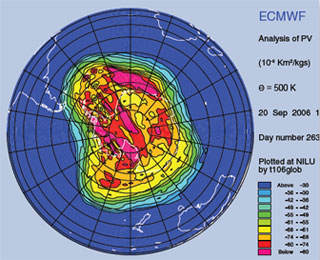Ozone hole near record size
Ozone hole near record size
mongabay.com
September 22, 2006
The World Meteorological Organization (WMO) said Friday that hole in the ozone layer over Antarctica will expand this year to 27.9 million square kilometers (10.8 million square miles), its second-highest recorded level in history.
The hole will fall short of the record set in 2000 of 28.5 million square kilometers (11 million square miles).
The hole in the ozone layer has been forming on a seasonal basis over Antarctic since the mid-1980s. Generally the hole is largest around late September.
 Click image for details. Courtesy of WMO.
|
The hole results from the “catalytic destruction” of ozone by atomic chlorine and bromine, the source of which is primarily chlorofluorocarbon (CFC) compounds known as “freons” and bromofluorocarbon compounds known as Halons. In 1987, following the discovery that these compounds were responsible for the ozone depletion in the upper atmosphere, the international community adopted the Montreal Protocol which banned the production of CFCs and halons as well as related ozone depleting chemicals.
Because the ozone layer prevents most harmful UVB wavelengths of ultraviolet light from entering the Earth’s atmosphere, ozone depletion is a significant concern. Increased penetration by UVB wavelengths of ultraviolet light is believed to heighten the incidence of skin cancer, damage plants, and reduce ocean plankton populations.
Scientists from NASA and other agencies believe that the ozone hole over the Antarctic will recover around 2068, nearly 20 years later than estimated in the late 1990s.
Ozone hole recovery slower than expected. Scientists from NASA and other agencies have concluded that the ozone hole over the Antarctic will recover around 2068, nearly 20 years later than previously believed. Researchers from NASA, the National Oceanic and Atmospheric Administration (NOAA) and the National Center for Atmospheric Research (NCAR) have developed a new tool, a math-based computer model, to predict the timing of ozone hole recovery. Their findings will be published tomorrow in Geophysical Research Letters.
Ozone Layer Recovering Finds Boulder Study. While Earth’s ozone layer is slowly being replenished following an international 1987 agreement banning CFCs, the recovery is occurring in a changing atmosphere and is unlikely to stabilize at pre-1980 levels, says a new University of Colorado at Boulder study.
This is article used information from Wikipedia.